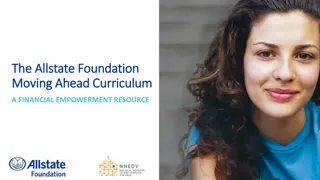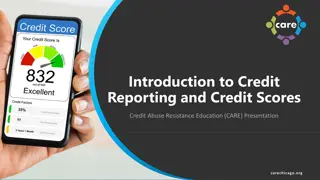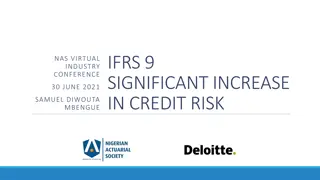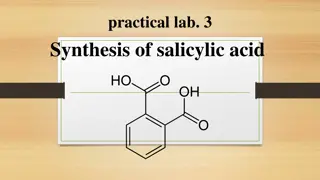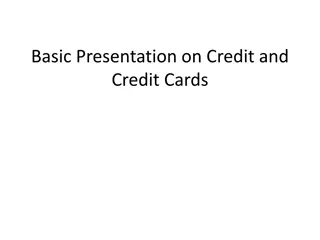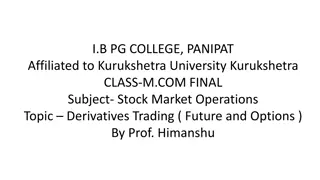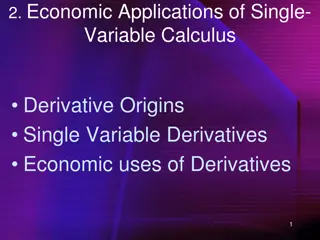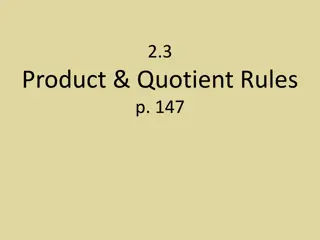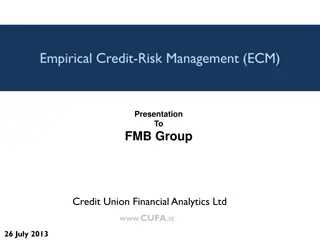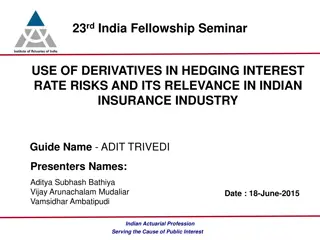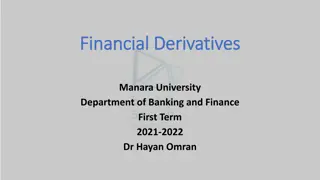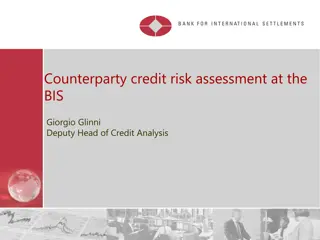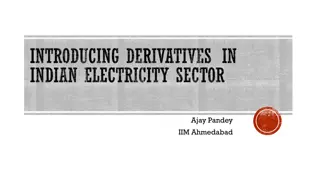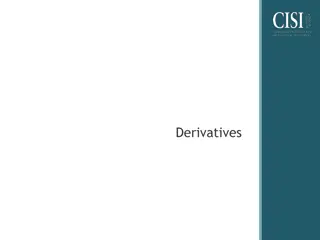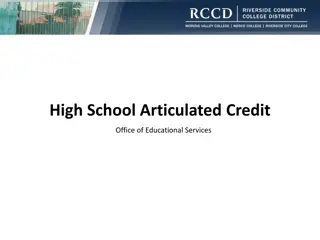Credit Risk Models and Derivatives Exploration
Delve into credit risk models and derivatives like credit default swaps (CDS) to understand the intricacies of credit risk, default risks, and credit spread risks. Explore the impact of ratings migration on bond grades and the implications for investors.
Uploaded on Apr 13, 2025 | 1 Views
Download Presentation

Please find below an Image/Link to download the presentation.
The content on the website is provided AS IS for your information and personal use only. It may not be sold, licensed, or shared on other websites without obtaining consent from the author.If you encounter any issues during the download, it is possible that the publisher has removed the file from their server.
You are allowed to download the files provided on this website for personal or commercial use, subject to the condition that they are used lawfully. All files are the property of their respective owners.
The content on the website is provided AS IS for your information and personal use only. It may not be sold, licensed, or shared on other websites without obtaining consent from the author.
E N D
Presentation Transcript
25782 ALTERNATIVE INVESTMENTS Week 5b: Credit Products
Introduction Part 1 of the lecture looks at two different credit risk models. Part 2 looks at credit derivatives, specifically credit default swaps (CDS). 2
Part 1: Credit Risk You want to place a bet that you will receive $2 million if the housing market prices fell? Where would you place your bet? Betting agency? Housing market? Investment banks? How would you draw up the betting contract? Consider: What are you betting on? What is the trigger event? What will you pay if you are wrong? What if you are right? What happens when your counterparty does not pay up? 3
Credit Risk Investopedia Definition: Credit risk is the possibility of a loss Credit risk is the possibility of a loss resulting from a borrower's failure to repay a loan or meet resulting from a borrower's failure to repay a loan or meet contractual obligations contractual obligations. Traditionally, it refers to the risk that a lender may not receive the owed principal and interest, which results in an interruption of cash flows and increased costs for collection. Interest payments from the borrower or issuer of a debt obligation are a lender's or investor's reward for assuming credit risk. Credit risk is the variability in financial outcomes Credit risk is the variability in financial outcomes related to firm failure of default. Unlike market risk, which is a systematic risk, credit risk contains idiosyncratic or firm-specific risk stemming from performance issues of individual securities. The exposure to credit risk in a corporate bond yields a limited upside that includes the receipt of promised interest payments and the recovery of principal, while the downside risk is the loss of the entire investment from bankruptcy or default. 4
Credit Risk The Three Forms of Credit Risk Three Forms of Credit Risk Default risk Downgrade risk Credit spread risk Default risk: Defaults depend on economic conditions (e.g. 00 tech bubble and 07- 08 GFC) Defaults cluster by industry (e.g. Tech or financials) Why do defaults peak after market crashes? 5
Credit Risk Downgrade risk / Credit Migration risk Ratings migration is when a bond moves up or down a ratings grade (e.g. from AA to A or C to Ca) Credit migration risk is the risk that a bond is determined by an agency to be of higher risk and therefore moved to a lower grade. The ratings matrix below shows migration of Single A and Single B rated bonds to other grades. 6
Credit Risk Credit Spread Risk Credit Spread Risk A credit spread reflects the difference in yield between a treasury and corporate bond of the same maturity. Bond credit spreads are often a good barometer of economic health - widening (bad) and narrowing (good). Credit spread risk is determined by changes in a bond s yields due to the buying and selling of a bond 7
Difference between the risks? The Three Forms of Credit Risk Default risk The chance that issuer won t make debt obligations Downgrade risk The risk that the ratings agency will downgrade the bond Prices of bonds will react to changes or even anticipated changes Factors depend on several issues including changes in default risk Credit spread risk Widening credit spreads indicate growing concern about the ability of issuer to service their debt. 8
Modelling credit risk Used to accurately measure credit risk for: Managing credit risk of assets. Price illiquid securities. Enhance risk-return profiles for hedge funds using relative value and arbitrage strategies. Two Models of Credit Risk Structural models: Directly model the factors that affect the default process (such as the behaviour of underlying assets and structure of cash flows). E.g. debt-to-equity ratio, asset volatility, cash flows. Reduced-form models: Models the probability of changes in credit ratings or default (outcomes) using market data such as yields, recovery rates and ratings change frequencies. Structural models start with factors to outcomes, reduced form Structural models start with factors to outcomes, reduced form models start with the outcome and find the factors that determine it. models start with the outcome and find the factors that determine it. 9
Modelling credit risk Arbitrage Arbitrage- -Free Risk Models Free Risk Models indicate that no investor would be able to earn a riskless profit greater than the risk-free rate of return. Used to price mispriced bonds (usually illiquid ones) The major steps to generating an arbitrage-free credit models are: 1. Develop a model of potential interest rates and credit spreads using a historical or simulated distribution 2. Derive the parameters of model from the market prices of bonds traded in competitive markets. 3. After the model has been parameterized, it can be used to value other securities. 4. Arbitrage-free pricing underlies both the structural and reduced-form credit models. 10
Structural Models Merton s Structural Model Merton s Structural Model uses put options to price credit-risky bonds. (A) Debt/equity relation: firm s equity = asset debt (B) Put-call parity: asset call option = risk-free bond put option Using the call option to represent the firm s securities, the following relationships are true: 1. firm s equity = call option on assets with strike price equal to debt face value, [from (A)] 2. firm s debt = asset - call option (1) 11
Structural Models From put-call parity, the put representation of the firm s securities is: 1. firm s equity (call option) = asset + put risk free bond [from (B)] 2. Equity- asset = put risk free bond (subtract asset both sides) 3. Asset equity = risk free bond put (by multiply by -1) 4. 4. firm s debt = risk free bond firm s debt = risk free bond put (2) put (2) The firm s risky-debt has two equivalent representations: - A covered call position on the firm s assets (1) - Owning risk-free bond and writing a put option on the firm s assets (2) 12
Structural Models Merton s structural model is formed such that the firm s risky debt is the combination of owning the risk-free debt and writing a put option on the firm s assets. What if the firm does well? What if the firm does poorly? From the option representations of the firm s capital structure, it is evident that equity and bondholders have conflicting desires for the volatility of firm assets. Given that options increase in value as volatility increases, equity holders, who are long volatility, desire higher volatility. Debtholders, who are short volatility, desire lower volatility. This is the underlying premise of the Merton model. 13
Structural Models Binomial Approach to Structural Models Binomial Approach to Structural Models The binomial approach to pricing risky debt assumes that the value of a firm can take on only one of two possible values at the end of the period. Assumes risk neutral pricing. The current value of the firm s assets is given by V(0). Using the risk-neutral pricing approach, the current value of the asset = 1 1+?[ ? ??1+( 1 ?) ??1) ] ? 0 = 14
Structural Models Risk Neutral vs. Risk Averse Example Consider a coin toss of $1 with the winning value being the coin ($1) The expected value under risk neutral probabilities being 0.5*0 +0.5*1 = 0.5 Somebody who is risk neutral is indifferent to a 100% guaranteed $0.50 or the $1 coin toss since the expected values are the same. Somebody who is risk averse would always prefer the guaranteed $0.50 over the $1 coin toss. They will only take the coin toss risk if the expected value of the coin toss exceeds $0.5. That is, they seek a premium for risk taking. 15
Structural Models Binomial Approach Equations Put value = Max (0, Debt - Assets) Merton model only assumes put value is priced at debt maturity. Credit spread = Yield rate - Risk free rate 16
Structural Models (Example) Binomial Example Suppose XYZ Corp s assets are $100. The value of its assets are expected to either increase or decrease by 30% over the next year. The one year risk free rate is 5%. The firm has one-period zero coupon debt outstanding with the notional (or principal) value of $80. Calculate the i) risk-neutral value of the debt now and ii) the credit spread. N.B. Notional value is the value of the debt at maturity. First calculate probability of upstate using binomial pricing of assets assets: Up state assets = 100*1.3=130 , Down state assets = 100*0.7 = 70 100 = (Up)*130 /1.05 + (1-Up)*70/1.05 so Up = 0.5833 17
Structural Models (Example) Binomial Example (cont d) 1. Since upstate= 0.5833, downstate = 1-0.5833 = 0.4167 2. Now calculate the put option value based on upstate probability: 3. Up state put = Max(80-130,0) =0, 4. Down state put = Max(80-70,0) = 10 5. Put value = 0.5833*0/1.05 + 10*0.4167/1.05 = $3.97 6. Since Debt = Risk Free Put then: 7. Debt = 80/1.05 3.97 = $72.22 $72.22 8. The one year yield is therefore 80/72.22 1 = 10.77% 9. The credit spread is 10.77%-5% = 5.77% 5.77% 18
Structural Models Advantages Advantages: Fixed-income securities can be priced using equity market data, which is reliable and easily obtainable. Structural models explain default based on fundamentals of the debt issuer (e.g. balance sheet position, market value of assets), which are often readily available. The model is flexible enough to price related fixed-income securities such as convertibles or different seniority issues. 19
Structural Models Disadvantages Disadvantages: Distortions in equity prices (e.g. bubbles) will misprice fixed-income securities. Thus we must be confident that asset values derived from equity prices are reasonable. Computed credit spreads from Merton s model are too low for very short term and very high- quality debt. Extensions of the model correct this irregularity but add more complexity to the estimation procedure. Data on firm liabilities may be unavailable due to an issuer s lack of transparency and accounting choices. 20
Reduced Form Models Reduced-form models do not explicitly attempt to model default probabilities. Instead, they take the market prices of liquid securities and infer the market s expectation of default, which can then be used to price illiquid securities. 21
Reduced Form Models Expected Loss is a function of three components: Probability of default (PD or ): The likelihood that the borrower will experience a credit event and not fulfill the contractual obligation. Exposure at default (EAD): The value of the position at the time of default. Loss given default (LGD): The loss to the lender given that the borrower has defaulted on the obligation. LGD = 1-R, where R is the recovery rate. Putting the three components together, the expected credit loss can be calculated as: Expected credit loss = x EAD x LGD = x EAD x (1-R) 22
Reduced Form Models The value of a risky bond can be calculated by discounting the face value of the bond by the risk-free rate plus a credit spread, s. i.e. s = bond yield risk free rate Consider a 1-period, zero-coupon risky bond with face value of K a one period risk-free rate of r. The PV of the risky bond can be modeled as the weighted average of a binomial process where the end of period values represent the default and non-default states. face value of K and If the bond defaults, assume recovery rate is R probability that the bond will default neutral probability that the bond will not default be worth K is (1- ). recovery rate is R, and the risk neutral default be worth K x R , and the risk Therefore, the PV of the bond is: 23
Reduced Form Models Pricing Credit Spreads Pricing Credit Spreads Also given B(0,1) = K/(1+r+s) [A bond s value is face value over risky discount] Then since K/(1+r+s) = * *(K*R)/(1+r) + (1- )*K/(1+r) (previous slide) We have: = 1/(1-R)*(s/(1+r + s ) Or approximately: s/(1-R) This is based on the fact a bond s yield is composed of a spread and a default risk component. Rearranging the formula also gives us: s *(1-R) 24
Reduced Form Models (Example) Assume the one-year risk-free rate is 5% and a one-year, zero-coupon bond yields 6%. The historical recovery rate for bond of this credit rating is 80%. Calculate the risk-neutral probability of default. Precise = 1/(1-R)x(s/(1+r + s ) Approximate s = x(1-R) Precise Approximate: s = x(1-R) = (1/(1-R))x(s/(1+r + s ) = (1/(1-.8))x(0.01/(1+.05 + .01 ) = 4.7% 0.01 = *(1-0.8) PD = 0.01/0.2 = 0.05 or 5% 25
Reduced Form Models Price illiquid bonds using parameters extracted from liquid bonds (e.g. probability of default) To infer spreads of different grade debt of the same company, particularly if one does not trade much. For arbitrage in pricing mispriced securities. 26
Part 2: Credit Derivatives Derivatives that transfer credit risk between parties are credit derivatives. Credit derivatives provide a method to diversify credit risk and provide liquidity during periods of credit stress. Credit derivatives payout when the underlying entity defaults. Buying credit derivatives is like buying insurance, except the payout is in the event of someone else defaulting (company, sovereign (country s government)) The difference is that credit derivatives are tradeable whereas insurance premiums generally are not. 27
Grouping Number of instruments: Single-name instruments: single entity s credit risk Multi-name instruments: multiple entity s credit risk Funded or Unfunded Unfunded credit instruments: Payout occurs at default. Exposure parties to counterparty risk. Funded credit instruments: Requires cash outlays. Sovereign (government) or non-sovereign Sovereign credit derivatives are more complex involving political and macroeconomic factors. 28
Credit Default Swap Credit default swap (CDS) is a bilateral OTC contract between a protection Credit default swap (CDS) is a bilateral OTC contract between a protection buyer (short credit risk) and a protection seller (long credit risk). buyer (short credit risk) and a protection seller (long credit risk). The credit protection seller and the credit protection buyer A trigger event (e.g. default of debtor) The credit buyer transfers all risk associated with the credit risky investment including the credit risk to the credit protection seller. 29
Total Return Swap TRS differs to CDS in that TRS sellers provides a fixed return in return for the underlying assets risky return. Does not require a trigger event to be named 30
CDS Mechanics CDS spread: CDS spread: Premium (fee) to be paid by buyer. Not to be confused with the credit spread! Contract size and maturity Contract size and maturity: Usually $20-$200M and 1- 10 years (5 years most typical maturity) Payment trigger events Payment trigger events: Most important part of contract The broader the definition, the more likely the event and the higher the spread (just like in insurance) Various events may be covered (next slide) Method of settlement Method of settlement: cash settle or physical settled. Usually upon trigger event, buyer transfers asset to seller and seller provides the par value of the bond to seller. Choice of assets assets to deliver: e.g. a bond 31
CDS Definition Four key parameters define a CDS: Credit reference Credit reference: Specifies reference asset Notional amount Notional amount: Amount of credit risk being transferred. Agreed between contractors. Similar to principal value of cash bond. CDS spread CDS spread: Annual payment, quoted in basis points. Usually paid quarterly. CDS maturity CDS maturity: Contracts typically expire 20th of Mar, Jun, Sep or Dec. 5 years contract usually the most common and most liquid. 33
CDS Example Credit reference: Airline company s qualifying senior unsecured paper Notional amount: $20 million notional CDS spread: 2% per year, paid quarterly. CDS maturity: 7 years 34
CDS Valuation CDS have no immediate cash payments either side. Since the premiums are the payments for protection. A buyer may however profit if CDS spreads increase, e.g. paid 100 bps but now similar contract worth 120 bps This is known as a mark-to-market adjustment for accounting reasons, recognizing a gain or loss and managing collateral. 35
Unwinding CDS Entering offsetting position. E.g. selling CDS with same maturity as previously bought one. Selling the CDS position to a dealer. Terminating a CDS by paying out any lost value from discontinuing the swap. 36
Participants Commercial banks: Act as market makers Bank loan portfolios: Developers of CDS. Use for hedging credit risk. Hedge funds: Profit from trading credit risk using various strategies (e.g. relative-value, volatility trading) Other asset managers: Investing purposes Insurance companies: Sell CDS to enhance returns on their asset portfolios. Increase revenues by selling credit protection. Corporations: Manage credit exposure to third parties. 37
Motivation Credit derivatives can efficiently isolate pure credit risk Synthetic short credit positions can be implemented cheaply and effectively Credit derivatives can synthetically create credit exposure without owning the underlying asset. Credit derivatives serve as a link between bond, loan, equity, and structured products markets Credit derivatives can provide much needed liquidity, particularly during market stress 38
Risks Risks differ from exchange traded market in that credit derivatives are traded OTC (direct with other institutions) Counter Counter- -party risk: party risk: Risk that counter party does not meet its obligations. Risk to buyer from seller. Particularly troubling when trigger event affects the liquidity of the credit protection seller (like Lehman Bros in GFC) Excessive leverage: Excessive leverage: risk since contracts have no upfront payment and are off-balance-sheet, despite large risk exposure. Proper accounting systems and back-office systems mitigate this risk. Pricing risk Pricing risk due to illiquidity and off exchange nature (as with other non-exchange traded assets) Liquidity risk Liquidity risk as uniqueness of contracts may find it difficult to find other willing parties to trade. Standardised contracts increase liquidity as market makers are likely to trade them. 39
Conclusion We have reviewed the concept of credit risk and how to model credit risk Credit derivatives provide protection to credit risk of other entities for buyers as well as income making opportunities to sellers. Due to the OTC nature of credit derivatives, the risks differ from exchange traded products. 40



